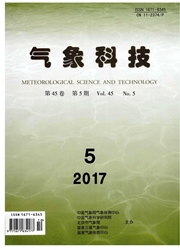

 中文摘要:
中文摘要:
基于能见度资料等级分析法、Ridit方法、“非常好”能见度及“较差”能见度出现频率分析法,分析了天津西青、塘沽两个气象观测站2000--2010年大气能见度变化趋势及低能见度天气特征,研究了影响大气能见度的主要因子。结果表明:11年间,两站能见度超过40km的情况均未出现,西青站2~9km能见度出现频率逐年上升,塘沽站从2006年开始20~39km能见度出现频率呈明显下降趋势;西青站从2006年开始,Ridit中值降至0.5以下,塘沽站Ridit中值呈波动式下降趋势,2006年Ridit中值最小(为0.43);两站“非常好”能见度出现频率呈逐渐下降趋势,“较差”能见度出现频率呈上升趋势;秋冬两季是西青、塘沽站低能见度天气的多发季,常伴有高湿度、低风速,两站的盛行风向存在差异;相对湿度与能见度呈负相关,风速与能见度呈正相关,与能见度波动式下降的趋势相反,能源消耗总量为逐年增加趋势。
 英文摘要:
英文摘要:
Atmospheric visibility trends in Xiqing and Tanggu meteorological stations in Tianjin from 2000the Ridit value has a fluctuant and decreasing trend, and the least Ridit value appeared in 2006 (0.43). The frequency of "very good" visibility appears to have a decline trend at both stations, while the frequency of "bad" visibility appears to have an increase trend. Autumn and winter are high-occurrence seasons of low-visibility weather, which is often accompanied by high relative humidity and low wind speed. The direction of the prevailing winds had differences at Xiqing and Tanggu stations. A negative correlation is found between relative humidity and atmospheric visibility, and wind speed and visibility has positive correlation. Visibility decreased in fluctuations, and on the contrary, total energy consumption increased year by year.
 同期刊论文项目
同期刊论文项目
 同项目期刊论文
同项目期刊论文
 期刊信息
期刊信息
